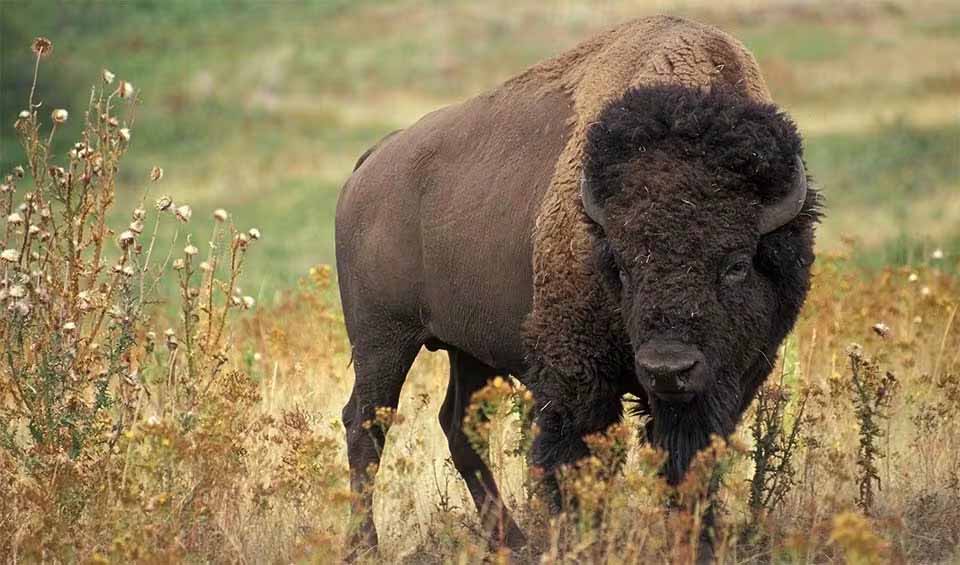The American bison, an emblem of the untamed wilderness that once sprawled across North America, boasts a history as vast and as rugged as the landscapes it roamed. Before the continent felt the full impact of European colonization, an estimated 60 million bison wandered the plains, their numbers so vast they became synonymous with the very spirit of the American West.
The American bison’s story took a dramatic turn in the 19th century, as the westward expansion of the United States brought unchecked commercial hunting and slaughter. Bison were hunted nearly to extinction, with their numbers dwindling alarmingly from millions to just a few hundred in a matter of decades. This tragic decline was compounded by the spread of bovine diseases from domestic cattle, introduced to the continent by settlers, which further decimated bison populations.
However, the narrative of the American bison is also one of resilience and recovery. In the late 19th and early 20th centuries, conservationists, Native American tribes, and the U.S. government began efforts to save the bison from the brink of extinction. Bison were reintroduced to their native habitats across the United States, from national parks to protected reserves. Thanks to these concerted conservation efforts, the population of wild bison has rebounded to approximately 20,000 individuals, with nearly half a million bison now raised as livestock on ranches and farms, marking a significant, though partial, recovery for the species.
Bison are not just remarkable for their history and size; they also possess unique behaviors that offer insights into their moods and intentions. One of the most telling signs of a bison’s mood is the position of its tail. Under normal, relaxed conditions, a bison’s tail hangs down and switches naturally, indicating a state of calm. However, when a bison’s tail stands straight up, it signals agitation or alertness, serving as a warning to both fellow bison and potential threats to tread carefully.
Distribution
 Canada
Canada United States
United States United States
United States Mexico
MexicoRecent updates
- 2023: According to All About Bison, as the US government extends significant support to Native tribes, a plan has been put in place to relocate the existing bison population, ensuring their welfare and preventing any harm in the process.
Did you know?
- The National Bison Legacy Act signed into law on May 9, 2016, designated North America’s Largest Mammal, the American bison as the nation’s official symbol and national mammal.
- Despite not yet becoming extinct in the wild, they have become ecologically extinct due to a lack of genetic variation required to keep their population alive and lower numbers in herds.
- Only 10 states in the United States categorize American bison as wildlife, either whole or in part. In other words, bison are legally considered livestock in the United States.
- In North America, 4,000 farms and ranches commercially breed about half-million American bison, those are kept for meat production and play no role as wildlife or in conservation.
- Bison and domestic cattle separated from a common ancestor roughly three million years ago; however, all American bison have low but considerable amounts of domestic cattle DNA due to hybridization. This occurred in a bid to save bison on a handful of private ranches after European immigrants attempted to eliminate the species.
- According to recent studies, bison increase the grassland ecosystem’s resistance to drought as they were once proven to be a keystone species in such ecosystems.
- According to recent studies, bison increase the grassland ecosystem’s resistance to drought as they were once proven to be a keystone species in such ecosystems.
- Bison have only existed consistently in the United States in Yellowstone National Park from ancient times until today.
- American bison are named ‘Buffalo,’ and their newborn calves, which are normally born between late March and May, are called “red dogs” because of their initial orange-red color.
- The national park service and the inter-tribal buffalo council (ITBC), which was established in 1992, collaborate to move bison from national park lands to the tribal territory. Bison is an integral part of these Tribes’ identity and they do not consider it as ‘cattle.’
Anything we've missed?
Help us improve this page by suggesting edits. Glory never dies!
Suggest an editGet to know me
Terrestrial / Aquatic
Altricial / Precocial
Polygamous / Monogamous
Dimorphic (size) / Monomorphic
Active: Diurnal / Nocturnal
Social behavior: Solitary / Pack / Herd
Diet: Carnivore / Herbivore / Omnivore / Piscivorous / Insectivore
Migratory: Yes / No
Domesticated: Yes / No
Dangerous: Yes / No
How did they disappear?

This mountain of buffalo skulls might give you some idea of how they could go from a few tens of million to few hundreds in 50 years.
One notable example is the intentional killing of buffalo by the U.S. Army to subjugate the Plains Indians. General Philip Sheridan, a military leader during the Indian Wars, reportedly stated, “Let them kill, skin, and sell until the buffalo is exterminated, as it is the only way to bring lasting peace and allow civilization to advance.”
American bison on banknotes






